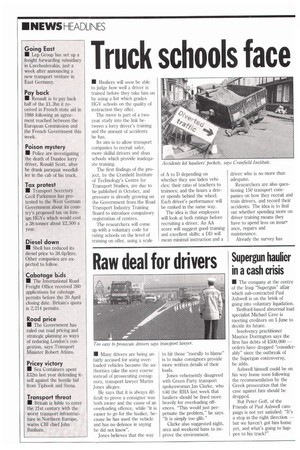Truck schools face quality test
Page 6

Page 7

If you've noticed an error in this article please click here to report it so we can fix it.
• Hauliers will soon be able to judge how well a driver is trained before they take him on by using a list which grades HGV schools on the quality of instruction they offer.
The move is part of a twoyear study into the link between a lorry driver's training and the amount of accidents he has.
Its aim is to allow transport companies to recruit safer, more skilful drivers and shun schools which provide inadequate training.
The first findings of the project, by the Cranfield Institute of Technology's Centre for Transport Studies, are due to be published in October, and pressure is already growing on the Government from the Road Transport Industry Training Board to introduce compulsory registration of centres.
The researchers will come up with a voluntary code for rating schools on the level of training on offer, using a scale of A to D depending on whether they use laden vehicles; their ratio of teachers to trainees; and the hours a driver spends behind the wheel. Each driver's performance will be ranked in the same way.
The idea is that employers will look at both ratings before recruiting a driver. An AA score will suggest good training and excellent skills; a DD will mean minimal instruction and a driver who is no more than adequate.
Researchers are also questioning 150 transport companies on how they recruit and train drivers, and record their accidents. The idea is to find out whether spending more on driver training means they have to spend less on insurt. ance, repairs and
maintenance.
Already the survey has found that many hauliers have little idea of how much minor, often unreported accidents caused by bad driving cost them, reports project leader Dr Derek Wright.
Because of the Government's attitude to compulsory training for drivers, teaching safe driving has become the sole responsibility of the haulage companies themselves, he told Commercial Motor last week. This means it has to be proved that spending on skills actually benefits hauliers' pockets. If the survey finds that it is cheaper to have accidents, it will then become a Government issue, he says.
Wright and his assistant, Dr Fariba Alamdari, have also sent questionnaires to 2,000 HGV drivers at the 150 'target' companies, asking them what sort of training they want, and how they rate their own abilities.
Most of the drivers admit to breaking the law to meet tight timetables. They also say they want re-training to iron out bad habits, particularly reversing. "They are not angels, but they have a professional interest in their job," says Alamdari.
The two-year study is wholly funded by 10 transport companies. These are: Boots, Interlink, NFC, Heronfreight, Cleanaway, Hoyer, BP, Roads, SA Bell and Richard Lawson. Its final findings will be published in October 1991, but Wright plans a meeting a year before that to raise some of the issues brought to light by the survey. About 50 of the companies taking part in the survey will be invited, with representatives of the Department of Transport and unions.
The success of the study will depend on whether it "raises the tempo of debate on HGV training," says Wright. "We want to produce a report that people will talk about. Not one that will sit on a library shelf."




































































































